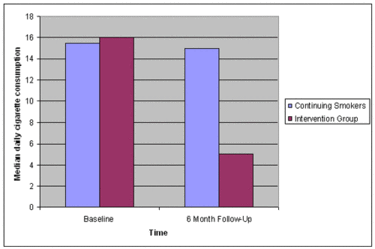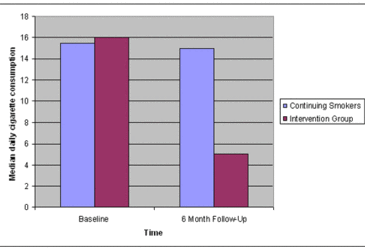Smoking cessation interventions vary in effectiveness (West, McNeill, & Raw, 2000) and scant research has examined how age impacts effectiveness. Most participants in smoking cessation studies are relatively young (Connolly, 2000). Perhaps investigators assume that older adults would not be interested in, or benefit from, smoking treatment, or that it would be easier to enroll younger adults in research. However, there is evidence that older adults are as responsive to cessation programs as younger adults (Glynn, 1988; Morgan et al., 1996). In this week’s ASHES, we examine recent research on a smoking cessation intervention among older adults.
Tait, Hulse, Waterreus, Flicker, Lautenshlager, Jamrozik, and Almeida (2007) recruited 215 current smokers, aged 68 years or older, from a community study of older men (Norman et al., 2004). This sample hailed from Perth, Western Australia and surrounding communities. The volunteers responded to media advertisements soliciting participants. Fifty participants (23%) reported that they did not want to quit smoking (i.e., continuing smokers) and 165 participants (77%) reported that they were interested in quitting (i.e., non-randomized intervention group). All participants provided demographic information, detailed smoking histories, and responded to the Fagerström Test of Nicotine Dependence (FTND). Investigators provided participants in the intervention group counseling, personalized educational materials, information about local services that help people to quit, and if requested, nicotine replacement therapy (NRT) patches. Trained staff members also called participants in the intervention group six different times during the study to offer support and guidance with weight management and coping strategies. Nearly all participants returned six months later (88% follow-up rate) for interviews; during this interview, they exhaled carbon monoxide (ECO) for a confirmation assessment.
Follow-up interviews indicated that 88.5% of the intervention group had attempted to quit smoking during the previous six months; at follow-up, 29% of the intervention group had remained abstinent for the 30 days prior to the follow-up, and an additional 20% of the group reported abstinence during the entire six-month period. None of the continuing smokers attempted to quit. In fact, Figure 1 shows, participants in the intervention group significantly decreased the median number of cigarettes smoked per day (Z=6.30, p<0.001), whereas the median number of daily cigarettes among continuing smokers remained the same.

Figure. Median daily cigarettes among continuing smokers and the intervention group. Click image to enlarge.
This study has limitations. These results might not generalize to other older adults. Participants self-selected either the control group or intervention group. Therefore, the cessation rates among the intervention group, a group of adults electing to quit smoking, might be higher than that of older adults in general. Moreover, the effectiveness of the specific intervention used in this study cannot be assessed; the success of the intervention group cannot be compared to that of the control group since the control participants did not share a fundamental characteristic with the intervention participants (i.e., expressing interest in quitting smoking).
This study’s findings indicate that some older adults are both interested in and capable of quitting smoking. Although this conclusion is simple, its implications are substantial. Firstly, the success of these older adults should influence future examinations of smoking cessation interventions (e.g., the populations targeted). Developing a greater understanding of older adults’ motivations to quit smoking could help engage a greater percentage of older adults in smoking cessation interventions. Secondly, the significant responses to this intervention should encourage physicians to provide advice about smoking cessation to all patients, no matter how old.
–Sara Kaplan.
References
Connolly, M. J. (2000). Smoking cessation in old age: Closing the stable door? Thorax, 29, 193-195.
Glynn, T. J. (1988). Relative effectiveness of physician-initiated smoking cessation programs. Cancer Bulletin 40, 359-364.
Morgan, G. D., Noll, E. L., Orleans, C. T., Rimer, B. K., Amfoh, K., & Bonney, G. (1996). Reaching midlife and older smokers: Tailored interventions for routine medical care. Preventative Medicine 25, 346-354.
Norman, P. E., Jamrozik, K., Lawrence-Brown, M. M., Le, M. T., Spencer, C. A., Tuohy, R. J., et al. (2004). Population based randomized controlled trial on impact of screening on mortality from abdominal aortic aneurysm. British Medical Journal 329, 1259-1262
Tait, R. J., Hulse, G. K., Waterreus, A., Flicker, L., Lautenshlager, N. T., Jamrozik, K., et al. (2007). Effectiveness of a smoking cessation intervention in older adults. Addiction 102, 148-155.
West, R., McNeill, A., & Raw, M. (2000). Smoking cessation guidelines for health professionals: An update. Thorax, 55, 987-999.
What do you think? Please use the comment link below to provide feedback on this article.





Sharma March 10, 2009
Smoking cessation interventions vary in effectiveness (West, McNeill, & Raw, 2000) and scant research has examined how age impacts effectiveness